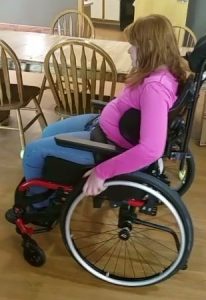Can Dynamic Seating Improve Function?

Dynamic Seating has improved Amanda’s ability to self-propel her manual wheelchair.
Michelle L. Lange, OTR/L, ATP/SMS
updated 11/11/2024
Our last blog answered the question, Can Dynamic Seating Improve Postural Control?. Research has demonstrated improvements in postural control, particularly in trunk and head control, with the use of Dynamic Seating. Research has further demonstrated that a Dynamic Seating intervention can improve function. Let’s take a look!
Improved functioning has been found in people using dynamic seating:
- Dynamic Seating allows movement while maintaining contact with the support surfaces, providing stability, and reducing shear forces (Chen, et al., 2018; Hahn, 2009; Cimolin, et al, 2009). Postural stability can improve functioning.
- Adlam (2015) found increased function with use of a dynamic seat in one study and in another (2014) one subject was able to access a switch when using dynamic seating.
- Incoronato (2007) found improvement of motor control of the upper extremities, trunk, and head.
- Dalton, (2014) found increased head and arm control with a simulated dynamic foot support.
In my own experience and in reports from other clinicians, suppliers, and clients – many have found an improvement in the use of assistive technology. As an example, Robert was able to use his communication device better.
A number of other functional changes have been documented.
- Increased range of motion and movement was found when using dynamic seating (Adlam, et al., 2014; Cimolin, et al., 2009; Hahn, et al., 2009; Incoronato, 2007).
- Dynamic seating improves digestion (Incoronato, 2007).
- Dynamic seating improves vocalization (Adlam, et al., 2014).
- Increasing movement improves circulation and has health benefits (Myers, et al., 2021).
- Adlam, et al. (2015) found increased social engagement with dynamic seating intervention.
So, what’s the bottom line? Dynamic Seating can improve function, including medical functioning. Now that is a clinical benefit I can get on board with!
References:
